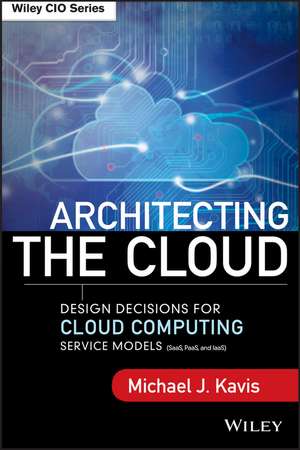Architecting the Cloud– Design Decisions for Cloud Computing Service Models (SaaS, PaaS, and IaaS): Wiley CIO
Autor MJ Kavisen Limba Engleză Hardback – 17 mar 2014
- Guides corporations through key cloud design considerations
- Discusses the pros and cons of each cloud service model
- Highlights major design considerations in areas such as security, data privacy, logging, data storage, SLA monitoring, and more
- Clearly defines the services cloud providers offer for each service model and the cloud services IT must provide
Din seria Wiley CIO
- 8%
 Preț: 504.32 lei
Preț: 504.32 lei - 20%
 Preț: 302.46 lei
Preț: 302.46 lei -
 Preț: 289.25 lei
Preț: 289.25 lei -
 Preț: 279.55 lei
Preț: 279.55 lei -
 Preț: 289.25 lei
Preț: 289.25 lei -
 Preț: 259.31 lei
Preț: 259.31 lei - 9%
 Preț: 886.43 lei
Preț: 886.43 lei -
 Preț: 276.70 lei
Preț: 276.70 lei - 8%
 Preț: 376.20 lei
Preț: 376.20 lei - 20%
 Preț: 235.15 lei
Preț: 235.15 lei -
 Preț: 278.03 lei
Preț: 278.03 lei -
 Preț: 261.98 lei
Preț: 261.98 lei - 20%
 Preț: 213.64 lei
Preț: 213.64 lei -
 Preț: 252.72 lei
Preț: 252.72 lei - 20%
 Preț: 185.78 lei
Preț: 185.78 lei -
 Preț: 252.72 lei
Preț: 252.72 lei - 20%
 Preț: 537.96 lei
Preț: 537.96 lei - 20%
 Preț: 205.19 lei
Preț: 205.19 lei - 8%
 Preț: 461.62 lei
Preț: 461.62 lei -
 Preț: 290.98 lei
Preț: 290.98 lei - 20%
 Preț: 183.14 lei
Preț: 183.14 lei -
 Preț: 137.22 lei
Preț: 137.22 lei - 8%
 Preț: 168.66 lei
Preț: 168.66 lei
Preț: 300.57 lei
Preț vechi: 375.71 lei
-20% Nou
57.51€ • 60.21$ • 47.59£
Carte disponibilă
Livrare economică 15-29 martie
Specificații
Public țintă
CTOs, enterprise architects, CFOs, CEOsDescriere
Praise for Architecting the Cloud: Design Decisions for Cloud Computing Service Models (SaaS, PaaS, and IaaS)
Cloud computing is truly changing the game for enterprise IT, and there are those that get it and those that don t. In this book Mike Kavis provides you with rock solid advice on how to truly make cloud computing work for your enterprise. Why is this different? Mike has actually done the real work. He s built clouds. He s solved real business problems using this technology. This book is important to the emerging world of cloud computing with real world guidance on how to succeed with cloud computing the first time. It should be required reading for anyone moving to the cloud.
David Linthicum, SVP Cloud Technology Partners, Author, Speaker, Blogger, and B List Geek
This is an important book for a number of reasons. The cloud is a transformational force in IT and Mike captures the forces at play and explains the impact in business and technical terms. The book covers the challenges we technologists face and the benefits businesses can realize. This book is not about products. It s about architecture. It will not be dated with the next new thing. The book explains what needs to be done to transform a business to a modern–cloud architecture in terms of people, processes, and technology.
The cloud is a disruptive technology. There will be winners and losers. Do yourself a favor and read this book and position yourself and your company to be a winner with a proper cloud roadmap and architecture as outlined in this excellent book.
Eric Roch, Principal Architect and Leader of the SOA and Cloud Practice for the IT consultancy Perficient Inc.
We live in an era which many pundits bemoan as lacking in economic vigor. Mike Kavis, however, sees something entirely different: amazing opportunities bubbling beneath the surface and ready to explode across the business landscape. He says we have entered a golden era of innovation, and he is spot on. Never before have so many resources been available to successfully launch and run a business, at relatively little cost. We are seeing an entire generation of businesses and business leaders coming on the scene who know only cloud, and are able to quickly experiment or act on new ideas, moving nimbly through their markets. This isn t just a world for startups, as larger enterprises are also learning to embrace cloud culture. But, as with any promising technology, it takes a keen sense of architecture and understanding of the organization to get it right. In this book, Mike provides a roadmap and inspiration to begin the journey to become a cloud–enabled enterprise.
Joe McKendrick, independent analyst and contributor to Forbes and CBS interactive ZDNet
Textul de pe ultima copertă
Praise for Architecting the Cloud: Design Decisions for Cloud Computing Service Models (SaaS, PaaS, and IaaS)
Cloud computing is truly changing the game for enterprise IT, and there are those that get it and those that don t. In this book Mike Kavis provides you with rock solid advice on how to truly make cloud computing work for your enterprise. Why is this different? Mike has actually done the real work. He s built clouds. He s solved real business problems using this technology. This book is important to the emerging world of cloud computing with real world guidance on how to succeed with cloud computing the first time. It should be required reading for anyone moving to the cloud.
David Linthicum, SVP Cloud Technology Partners, Author, Speaker, Blogger, and B List Geek
This is an important book for a number of reasons. The cloud is a transformational force in IT and Mike captures the forces at play and explains the impact in business and technical terms. The book covers the challenges we technologists face and the benefits businesses can realize. This book is not about products. It s about architecture. It will not be dated with the next new thing. The book explains what needs to be done to transform a business to a modern–cloud architecture in terms of people, processes, and technology.
The cloud is a disruptive technology. There will be winners and losers. Do yourself a favor and read this book and position yourself and your company to be a winner with a proper cloud roadmap and architecture as outlined in this excellent book.
Eric Roch, Principal Architect and Leader of the SOA and Cloud Practice for the IT consultancy Perficient Inc.
We live in an era which many pundits bemoan as lacking in economic vigor. Mike Kavis, however, sees something entirely different: amazing opportunities bubbling beneath the surface and ready to explode across the business landscape. He says we have entered a golden era of innovation, and he is spot on. Never before have so many resources been available to successfully launch and run a business, at relatively little cost. We are seeing an entire generation of businesses and business leaders coming on the scene who know only cloud, and are able to quickly experiment or act on new ideas, moving nimbly through their markets. This isn t just a world for startups, as larger enterprises are also learning to embrace cloud culture. But, as with any promising technology, it takes a keen sense of architecture and understanding of the organization to get it right. In this book, Mike provides a roadmap and inspiration to begin the journey to become a cloud–enabled enterprise.
Joe McKendrick, independent analyst and contributor to Forbes and CBS interactive ZDNet
Cuprins
Foreword xiii
Preface xv
Acknowledgments xix
About the author xxi
Chapter 1 Why Cloud, Why Now? 1
Evolution of Cloud Computing 3
Enter the Cloud 6
Start–Up Case Study: Instagram, from Zero to a Billion Overnight 8
Established Company Case Study: Netflix, Shifting from On–Premises to the Cloud 9
Government Case Study: NOAA, E–mail, and Collaboration in the Cloud 10
Not–for–Profit Case Study: Obama Campaign, Six–Month Shelf–Life with One Big Peak 10
Summary 11
Chapter 2 Cloud Service Models 13
Infrastructure as a Service 13
Platform as a Service 15
Software as a Service 17
Deployment Models 18
Summary 22
Chapter 3 Cloud Computing Worst Practices 23
Avoiding Failure When Moving to the Cloud 23
Migrating Applications to the Cloud 23
Misguided Expectations 27
Misinformed about Cloud Security 29
Selecting a Favorite Vendor, Not an Appropriate Vendor 31
Outages and Out–of–Business Scenarios 31
Underestimating the Impacts of Organizational Change 33
Skills Shortage 35
Misunderstanding Customer Requirements 36
Unexpected Costs 37
Summary 39
Chapter 4 It Starts with Architecture 41
The Importance of Why, Who, What, Where, When, and How 41
Start with the Business Architecture 43
Identify the Problem Statement (Why) 47
Evaluate User Characteristics (Who) 48
Identify Business and Technical Requirements (What) 48
Visualize the Service Consumer Experience (Where) 49
Identify the Project Constraints (When and with What) 51
Understand Current State Constraints (How) 52
Summary 54
Chapter 5 Choosing the Right Cloud Service Model 55
Considerations when Choosing a Cloud Service Model 56
When to Use SaaS 59
When to Use PaaS 62
When to Use IaaS 65
Common Cloud Use Cases 68
Summary 69
Chapter 6 The Key to the Cloud: RESTful Services 71
Why REST? 72
The Challenges of Migrating Legacy Systems to the Cloud 74
Summary 75
Chapter 7 Auditing in the Cloud 77
Data and Cloud Security 78
Auditing Cloud Applications 78
Regulations in the Cloud 80
Audit Design Strategies 83
Summary 85
Chapter 8 Data Considerations in the Cloud 87
Data Characteristics 87
Multitenant or Single Tenant 92
Choosing Data Store Types 95
Summary 98
Chapter 9 Security Design in the Cloud 99
The Truth about Data in the Cloud 100
How Much Security Is Required 101
Responsibilities for Each Cloud Service Model 104
Security Strategies 108
Areas of Focus 110
Summary 118
Chapter 10 Creating a Centralized Logging Strategy 119
Log File Uses 119
Logging Requirements 120
Summary 124
Chapter 11 SLA Management 127
Factors That Impact SLAs 127
Defining SLAs 130
Managing Vendor SLAs 132
Summary 135
Chapter 12 Monitoring Strategies 137
Proactive vs. Reactive Monitoring 137
What Needs to Be Monitored? 138
Monitoring Strategies by Category 139
Monitoring by Cloud Service Level 145
Summary 147
Chapter 13 Disaster Recovery Planning 149
What Is the Cost of Downtime? 149
Disaster Recovery Strategies for IaaS 151
Recovering from a Disaster in the Primary Data Center 152
Disaster Recovery Strategies for PaaS 157
Disaster Recovery Strategies for SaaS 159
Disaster Recovery Hybrid Clouds 160
Summary 162
Chapter 14 Leveraging a DevOps Culture to Deliver Software Faster and More Reliably 163
Developing the DevOps Mind–Set 163
Automate Infrastructure 165
Automate Deployments 166
Design Feature Flags 167
Measure, Monitor, and Experiment 167
Continuous Integration and Continuous Delivery 168
Summary 170
Chapter 15 Assessing the Organizational Impact of the Cloud Model 171
Enterprise Model vs. Elastic Cloud Model 172
IT Impact 173
Business Impacts 174
Organization Change Planning 178
Change in the Real World 180
Summary 181
Chapter 16 Final Thoughts 183
The Cloud Is Evolving Rapidly 183
Cloud Culture 185
New Business Models 186
PaaS Is the Game Changer 187
Summary 190
Index 193
Notă biografică
MICHAEL J. KAVIS is Principal Architect at Cloud Technology Partners, a vendor independent, cloud–exclusive, nimble alternative to large technology consultants. He has served in numerous technical roles such as CTO, Chief Architect, and Vice President and has over 25 years of experience in software development and architecture. Kavis is a pioneer in cloud computing and led a team that built the world s first high–speed transaction network in Amazon s public cloud. He is the former CTO of startup M–Dot Network, which won the 2010 Amazon AWS Global Startup Challenge.




















